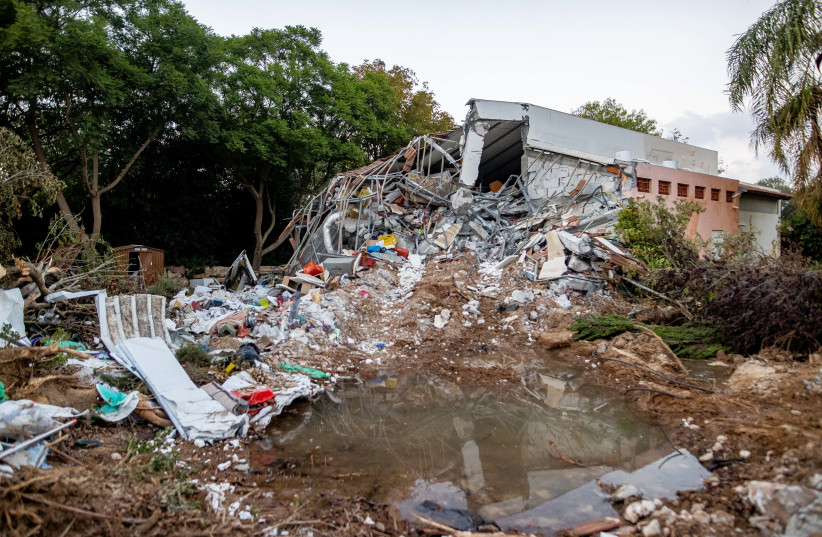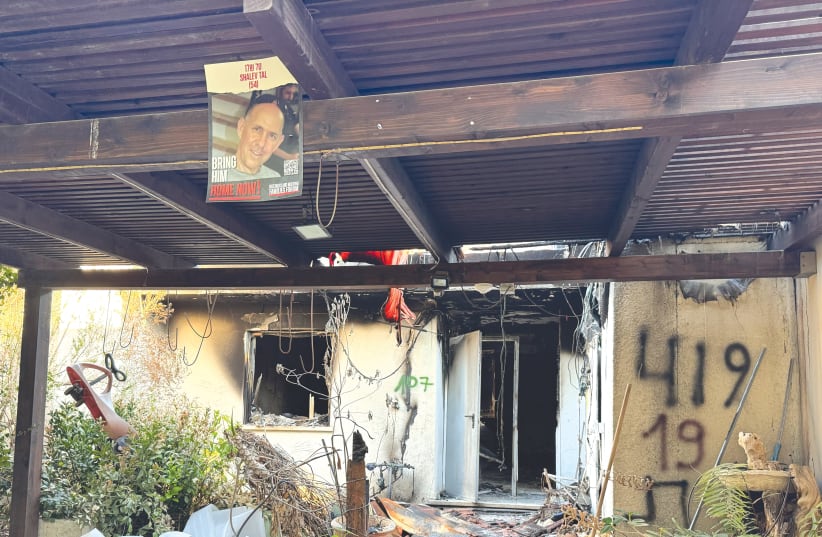At this crucial moment, there’s a troubling silence about preserving the evidence of the harrowing events of October 7. Rushing to rebuild, demolition crews are already erasing the scars of tragedy, bulldozing destroyed homes in Be’eri. It’s unacceptable. Life must go on, but the lack of a clear plan to protect vital artifacts and potential memorials is problematic. The demolitions need to stop.
During recent visits to Auschwitz, the Supernova site, and Nir Oz, I witnessed the profound impact of allowing evidence to speak for itself.
Countless solidarity and educational trips have already visited the October 7 areas to bear witness. My group was the 78th such cohort led by just one guide, a first responder after the attacks. Our journey was tied to a minimum donation for rebuilding Nir Oz which is pursuing a two-year, $83 million reconstruction plan.

Argentina’s President, Javier Milei, had visited Nir Oz just days before.
The first stop on our solidarity trip was near Tkuma, where about 1,800 destroyed vehicles are stacked, several deep. There was no room for our group to enter, due to the jam of other buses and groups of touring soldiers. The smashed vehicles are already quite rusted. Noting this, one woman asked how they would be preserved. The reply was “there’s no plan yet.”
Next was the Supernova massacre site. No signs remain, as all vehicles and venue remains were removed. The lightly wooded area is bustling with diverse groups, such as soldiers and religious female students who come to pay respects, sing group songs, and share words of encouragement. Only a little scorched earth is still visible from beneath a layer of lush ground and blooming scarlet anemone wildflowers. It was a natural choice for a music festival.
At Nir Oz, we saw the posters of hostages and victims that are plastered across the country. Here, the posters are on the doors of the homes, where those pictured were snatched, assaulted, and murdered; providing a physical anchor to the tragic stories we all know.
There’s the Bibas home, with baby Kfir’s toys still spilled around the porch, waiting for him abducted at 9 months, to come home.
Nearby is the home of Yaffa Adar, the 85-year-old great-grandmother and Holocaust survivor infamously hauled off to Gaza on a golf cart. It felt like stepping into a crime scene. Residents shared the vivid stories behind the scars on every home. Plastic chairs are still positioned near mounds of ash, where recovery workers sat and sifted for human remains. Some on the tour asked about preservation plans, but it seemed there were none.
As weeks go by and the ashes are blown away, evidence of the devastation is disappearing. This began with the repainting of roadside bomb shelters. Lacking doors, these tight concrete spaces were intended to shield people from projectiles landing from above. Israelis sought cover from terrorists inside them, only to be killed with grenades. Those who tried to flee were gunned down. In January, the transportation authority hastily painted over the charred walls without consulting the authority responsible for reconstruction.
In Sderot, by the end of October, there was no trace of the destroyed police station. Although a memorial is planned nearby, the rubble was recklessly removed by an unvetted contractor and illegally dumped in a nature preserve. Environmentalists tracked down the debris after discovering that the police superintendent’s personal effects were among it. One group of visual researchers, from the Ben-Zvi Institute, is racing against time to recover and save thousands of key items from being lost.
Preservation versus authenticity
It’s difficult to preserve such sites while maintaining authenticity. In Auschwitz-Birkenau, 80 years and two million annual visitors take a toll. The rusting barbed wire is regularly replaced, the wooden barracks are reconstructed and weather-proofed on new foundations, and the once-barren muck is now mowed grass. The 4,000 pounds of hair and 100,000 leather shoes are decaying, losing much of their colors. The crematoria are rebuilt or propped up in a last stand against time.
Some say the Birkenau camp should be reclaimed by nature. During a visit, however, you’re shocked by the 430-acre vastness of a purpose-built death factory. It’s an experience that cannot be interiorized through a Netflix special or even from firsthand survivor accounts.
The main effort to memorialize October 7, led by Israel’s Heritage Ministry, is a digital simulation of what the area looked like after the attacks, using scans to create a “Yad Vashem 2.0.”
But there’s a reason why countless people divert for day trips from Krakow or from Tel Aviv. In a world rapidly moving toward virtual reality, what’s tangible is what truly makes an impression. During his Nir Oz tour, Argentina’s Milei drew parallels with the Holocaust, reflecting that, “When we saw the pictures, we were filled with horror; but now to see things for myself, up close, it is an all the more disturbing and powerful experience.”
It’s also understandable not to want to dwell too much on these tragedies. Some, like People Love Dead Jews author Dara Horn, caution against centering Jewish identity on these grim locations.
Former parliament member Moshe Feiglin once likened Jerusalem’s Holocaust museum, Yad Vashem, to a metaphorical Third Temple “of our existence, the place where we bring all the visiting dignitaries, explaining to them that we are here because, if not, they burn us to ashes.” He argues that Israel’s destiny is “intertwined” with the Temple Mount.
Right now, preserving the memory of October 7 prompts a needed confrontation between the West, Hamas, and the embattled “Never Again” mantra. Holocaust survivors were again abandoned to face the brunt of monsters hellbent on repeating history.
These destroyed areas mark the paradigm shift in Israel’s existential struggle.
While Hamas (and potentially some Israeli politicians) may celebrate the removal of evidence, these remnants are “Exhibit A” to justify a new reality in the Gaza Strip and the West Bank [Judea and Samaria]. For those who don’t see Israel’s destiny in a religious or historical context, places like Nir Oz offer a chance to stand at the event horizon separating barbarism and civilization.
The situation presents a dilemma of preserving history and supporting displaced families still waiting to return home. The return of thriving families to these communities is the ultimate comeback to Jew-hatred. There must be a middle ground that also respects the victims’ sacred memory, and shows the world that so long as Hamas survives, “Never Again” is no guarantee.
For this opportunity to remain even a year from now, there must be a pause to demolitions. A compassionate review process, led by residents, preservationists, and international Jewish organizations, is sorely needed.
The writer is a Middle East analyst and was a sergeant in the IDF’s Nahal infantry brigade during the 2014 Gaza War. He holds an MA in Middle Eastern Studies from The University of Chicago.
